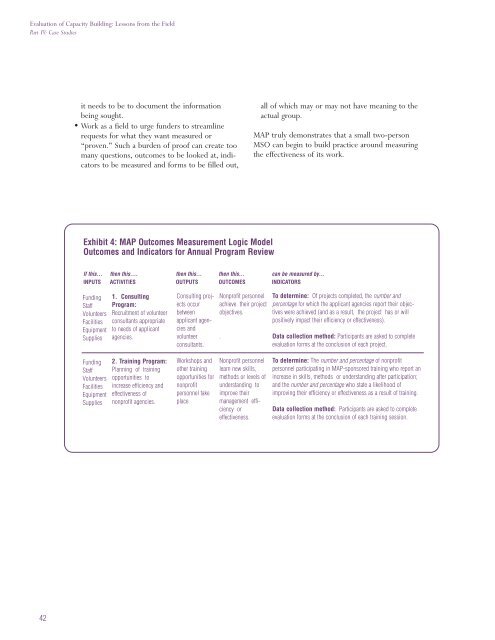Lessons from the Field - Seer Consulting
Lessons from the Field - Seer Consulting
Lessons from the Field - Seer Consulting
Create successful ePaper yourself
Turn your PDF publications into a flip-book with our unique Google optimized e-Paper software.
Evaluation of Capacity Building: <strong>Lessons</strong> <strong>from</strong> <strong>the</strong> <strong>Field</strong><br />
Part IV: Case Studies<br />
42<br />
it needs to be to document <strong>the</strong> information<br />
being sought.<br />
• Work as a field to urge funders to streamline<br />
requests for what <strong>the</strong>y want measured or<br />
“proven.” Such a burden of proof can create too<br />
many questions, outcomes to be looked at, indicators<br />
to be measured and forms to be filled out,<br />
Exhibit 4: MAP Outcomes Measurement Logic Model<br />
Outcomes and Indicators for Annual Program Review<br />
If this… <strong>the</strong>n this…. <strong>the</strong>n this… <strong>the</strong>n this… can be measured by…<br />
INPUTS ACTIVITIES OUTPUTS OUTCOMES INDICATORS<br />
Funding<br />
Staff<br />
Volunteers<br />
Facilities<br />
Equipment<br />
Supplies<br />
Funding<br />
Staff<br />
Volunteers<br />
Facilities<br />
Equipment<br />
Supplies<br />
1. <strong>Consulting</strong><br />
Program:<br />
Recruitment of volunteer<br />
consultants appropriate<br />
to needs of applicant<br />
agencies.<br />
2. Training Program:<br />
Planning of training<br />
opportunities to<br />
increase efficiency and<br />
effectiveness of<br />
nonprofit agencies.<br />
<strong>Consulting</strong> projects<br />
occur<br />
between<br />
applicant agencies<br />
and<br />
volunteer<br />
consultants.<br />
Workshops and<br />
o<strong>the</strong>r training<br />
opportunities for<br />
nonprofit<br />
personnel take<br />
place<br />
Nonprofit personnel<br />
achieve <strong>the</strong>ir project<br />
objectives.<br />
.<br />
Nonprofit personnel<br />
learn new skills,<br />
methods or levels of<br />
understanding to<br />
improve <strong>the</strong>ir<br />
management efficiency<br />
or<br />
effectiveness.<br />
all of which may or may not have meaning to <strong>the</strong><br />
actual group.<br />
MAP truly demonstrates that a small two-person<br />
MSO can begin to build practice around measuring<br />
<strong>the</strong> effectiveness of its work.<br />
To determine: Of projects completed, <strong>the</strong> number and<br />
percentage for which <strong>the</strong> applicant agencies report <strong>the</strong>ir objectives<br />
were achieved (and as a result, <strong>the</strong> project has or will<br />
positively impact <strong>the</strong>ir efficiency or effectiveness).<br />
Data collection method: Participants are asked to complete<br />
evaluation forms at <strong>the</strong> conclusion of each project.<br />
To determine: The number and percentage of nonprofit<br />
personnel participating in MAP-sponsored training who report an<br />
increase in skills, methods or understanding after participation;<br />
and <strong>the</strong> number and percentage who state a likelihood of<br />
improving <strong>the</strong>ir efficiency or effectiveness as a result of training.<br />
Data collection method: Participants are asked to complete<br />
evaluation forms at <strong>the</strong> conclusion of each training session.


